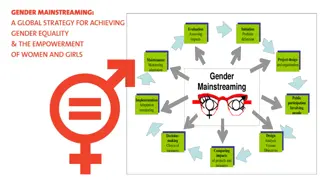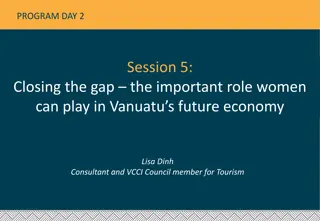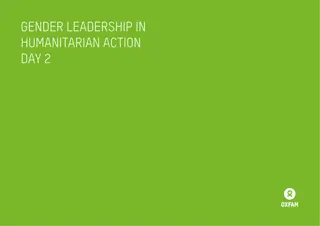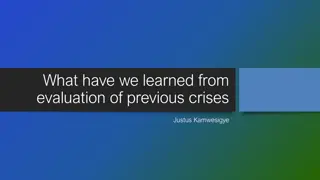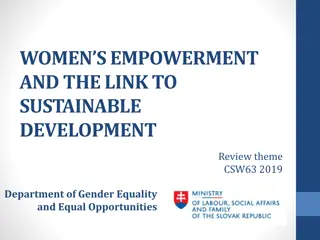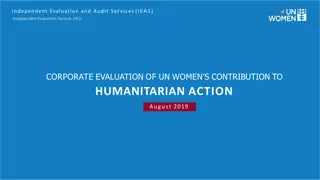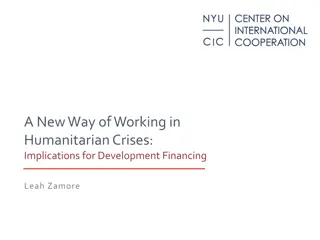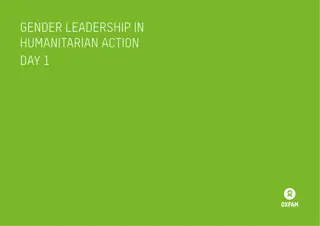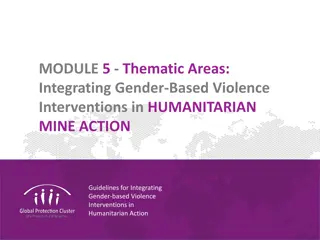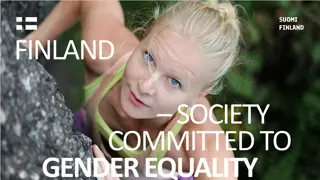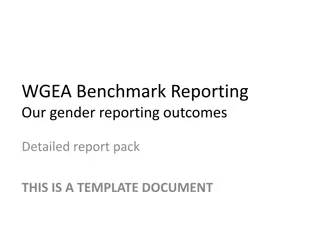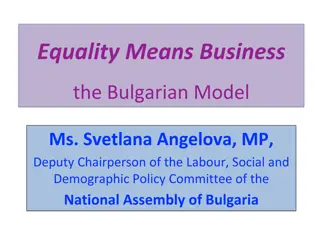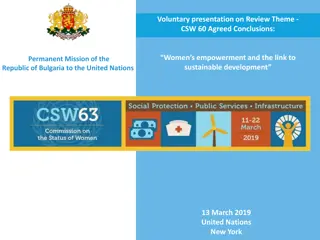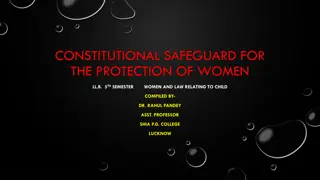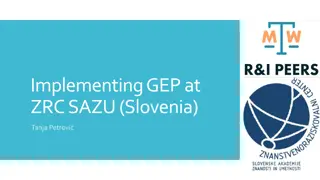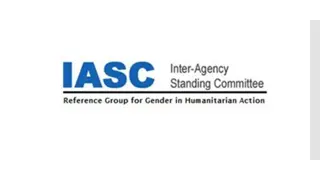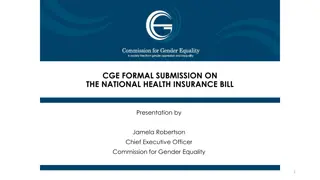Gender Equality in Humanitarian Crises: Empowering Women and Girls
Addressing gender equality in humanitarian crises is crucial for empowering women and girls. Access and participation in facilities and activities, meaningful participation, dignity, and empowerment are key aspects to consider. Women's empowerment spans various spheres and requires holistic approaches. Improving disaster preparedness, response effectiveness, and inclusive peace-building are essential for advancing gender equality during crises.
Download Presentation

Please find below an Image/Link to download the presentation.
The content on the website is provided AS IS for your information and personal use only. It may not be sold, licensed, or shared on other websites without obtaining consent from the author.If you encounter any issues during the download, it is possible that the publisher has removed the file from their server.
You are allowed to download the files provided on this website for personal or commercial use, subject to the condition that they are used lawfully. All files are the property of their respective owners.
The content on the website is provided AS IS for your information and personal use only. It may not be sold, licensed, or shared on other websites without obtaining consent from the author.
E N D
Presentation Transcript
Slide 1 Access and participation Access to facilities, services and information (e.g. latrines, wash points, non-food item distributions, entitlements) must be equally and safely accessible to women, girls, men and boys. Participation in activities such as meetings, committees, and training and employment programmes must also be equal and safe for all.
Slide 2 Meaningful participation Participation must be safe, equal and meaningful for women, girls, men and boys. It s not just about who is involved in project activities but how they are involved. There are different levels: from attendance, to consultation, to self-mobilizing action linked toempowerment. Key questions Are women and girls actively contributing to discussions? Are they making decisions? Are they involved in matters relevant to the broader community or are they just asked about women s issues ?
Slide 3 Dignity is about having your needs met in a respectful way. This will not happen if you are ignored, discriminated against, insulted, or embarrassed. The needs of an individual will differ in every cultural context so preserving dignity means consulting women and girls on what is needed.
Slide 4 Empowerment is the process of gaining control over the self, over ideology and the resources that determine power. Women s empowerment is the process through which women, individually and collectively, become aware of how power structures operate in their lives and gain the confidence to challenge the resulting gender inequalities.
Slide 5 Women s empowerment can take place in different interdependent spheres Achieving transformational change in power relations between women and men means working across all these interdependent dimensions of women s empowerment in a holistic way: economic; social; political; personal; legal.
Slide 6 What do we need to do to work above the line on gender equality during humanitarian crises? Better disaster preparedness and risk reduction More efficient and effective humanitarian response Inclusive and sustainable peace-building and conflict resolution in communities
Slide 7 1. Better disaster preparedness and risk reduction Women frequently act as effective leaders in mobilizing communities to reduce the risk of, and prepare for, disaster. Increasingly they lead initiatives to adapt to the impact of climate change, where their knowledge of natural resource management has often proved critical to community survival.
Slide 8 2. More efficient and effective humanitarian response There are multiple examples where grassroots women crisis responders have successfully organized themselves to lead humanitarian interventions, often in areas that international agencies have not been able to reach or remain in.
Slide 9 3. Inclusive and sustainable peace-building and conflict resolution in communities Research on the implementation of UN Security Council Resolution 1325 provides irrefutable evidence that women s participation in peace processes significantly increases the likelihood of peace agreements being reached and implemented. Agreements were 35% more likely to last for at least 15 years where women were included as witnesses, signatories, mediators or negotiators.
Slide 10 Barriers to women s leadership in humanitarian response persistent perception of women as victims rather than resilient survivors/ active agents; exclusion from humanitarian decision making structures; lack of systematic data on the impact of grassroots women responders and their organizations; lack of funding to women s rights organizations.
Slide 11 What action is needed to strengthen women s leadership in humanitarian action? direct funding to women s rights organizations for preparedness, response, advocacy and core admin costs; scale up training opportunities for local women leaders in emergency preparedness and response; commitment to gender parity in all community-led, national and international representation structures overseeing emergency preparedness and response; establishing a mechanism within the UN humanitarian coordination system that focuses on gender equality in humanitarian response, including engagement of women s rights organizations.
Slide 12 World Humanitarian Summit, May 2016 Commitment to action gender-sensitive humanitarian response; draw on expertise of local women and women s groups and empower them as central actors, leaders and agents ofchange; scale up assistance and support to women s groups; increase % of implementing partners that are women s groups.
Slide 13 Transformative leadership for women s rights This is about more than getting more women into positions of power and leadership. We also need to think about the quality and intention of their leadership. It is about leadership for sustainable change that challenges the root causes of inequality and builds an enabling environment for the leadership potential of individuals. It means focusing on the politics and practice of power and rethinking leadership with the aim of developing and modelling more equal and inclusive leadership styles.
Slide 14 TLWR has a twofold goal improving the way leadership is exercised more equitable, inclusive, democratic, open, consultative, collective, supportive, self-aware; using that leadership to achieve gender justice goals, specifically gender-equitable humanitarian action.
Slide 15 Programme approaches for transformative leadership for women srights Support to individual women to understand their rights and take up leadership positions; strengthen technical and influencing skills of women leaders. Support to women s collective action (alliances, networks) that promotes a women s rights agenda across sectors (including humanitarian) and support for safer and more effective influencing. Closing the policy practice gap - e.g. legal and policy reform to support women s leadership, implementation of reforms. Creates an enabling environment - e.g. challenges social norms and expectations re. women s leadership; creates safe spaces for women to organize and influence; reduces violence against women and women s time poverty; increases investment for women s rights at work.
Slide 16 Engaging men and boys Men and boys can be important allies and change agents in transforming damaging social norms (beliefs and behaviours), and helping to minimize backlash from men when patriarchy is challenged.
Slide 17 How can humanitarians engage with this agenda alongside the immediacy of life-saving work? By building mutually supportive partnerships between women activists, leaders and movements engaged in long-term women s rights work, and those involved in delivering humanitarian aid.
Slide 18 What would a mutually supportive partnership look like? Humanitarians can support local and national women s rights organizations and, in turn harness their support, by: recognizing their knowledge, expertise, influencing power, transformative women s rights agenda, and working with them to develop inclusive leadership; strengthening their capacity to engage strategically in humanitarian action by funding them, offering training, and ensuring their representation in decision making bodies; supporting their wider long-term agendas, including creating an enabling environment for women s rights.
Slide 19 Gender-based violence (GBV) is an umbrella term for any harmful act that is perpetrated against a person s will and that is based on socially ascribed (i.e. gender) differences between males and females. It includes acts that inflict physical, sexual or mental harm or suffering, threats of such acts, coercion, and other deprivations of liberty. These acts can occur in public or in private. Source: IASC GBV Guidelines(2015) Violence against women (VAW) is described in the United Nations Declaration on the Elimination of Violence Against Women as any act of GBV that results in, or is likely to result in, physical, sexual or psychological harm or suffering to women, including threats of such acts, coercion or arbitrary deprivation of liberty, whether occurring in public or in private life . Source: UN Women http://www.un.org/womenwatch/daw/vaw/reports.htm
Slide 20 GBV: Women or men? While the term gender-based violence is used to describe some forms of violence against men and boys, most acts of GBV are directed against women and girls because in many contexts, they are disadvantaged in terms of social power and influence, control of resources, control of their bodies and participation in public life, making them more vulnerable to violence. Source: IASC GBV Guidelines(2015)
Slide 21 The key characteristics of any act of GBV are: it involves the abuse of power by the perpetrator (e.g. teachers, husbands, aid workers); it involves some type of force, including threats and coercion; there is a lack of informed consent; it is a violation of fundamental human rights.
Slide 22 Types of GBV sexual violence: rape, attempted rape, forced pregnancy or abortion, forced prostitution, sexual harassment or abuse and sexual exploitation physical violence: domestic violence, assault psychological violence: verbal or emotional abuse, humiliation, discrimination, confinement, denial of opportunities or access to services economic violence: denial of access to money within the household harmful traditional practices include sexual, physical and psychological violence e.g. female genital mutilation, harm to men s genitals, forced early marriage, widow killings, and so-called honour- killings domestic violence or intimate partner violence can involve any single type, or a combination of the types of violence outlined above.
Slide 23 The scope of the problem is immense Gender-based violence is serious, life-threatening and global. During humanitarian emergencies GBV is known to increase. Examples During the genocide in Rwanda in 1994, it is estimated that between 250,000 and 500,000 women survived rape. In the Democratic Republic of Congo, a study in 2011 estimated that 48 women were raped every hour.
Slide 24 What do we mean by Do No Harm ? The concept of do no harm means that humanitarian organizations must strive to minimize the harm they may inadvertently be doing by being present and providing assistance. Such unintended negative consequences may be wide-ranging and extremely complex... Source: IASC GBV Guidelines, 2015, p45
Slide 25 Do No Harm and GBV Humanitarian actors can reinforce the Do NoHarm principle in their GBV-related work through careful attention to the human rights-based, survivor-centred, community-based and systemsapproaches.
Slide 26 Why you should not wait for evidence of GBV before acting GBV is happening everywhere and is under- reported worldwide due to fears of stigma or retaliation, limited availability of trusted service providers, and impunity for perpetrators. There are also huge safety and ethical challenges involved in collecting data on prevalence in times of crises. Therefore, all humanitarian personnel should assume that GBV is occurring in populations in crisis, treat it as a life-threatening problem, and take action based on the detailed IASC GBV Guidelines for their sector.
Slide 27 Key questions to establish the relative safety of women, girls, men and boys What are the social attitudes toward gender-based violence? Is it more common since the crisis began? What forms of interpersonal violence and organized violence are common in this society? Do female and male survivors of sexual and other interpersonal violence have access to justice? Are perpetrators likely to be punished? Do people in this society understand their human rights and have access to human rights defenders? What are the social attitudes toward small armsand light weapons? Are there large numbers of former or current combatants in this society? To what extent are police services functioning in this society?
Slide 28 Protecting affected populations from the risk of GBV From the earliest stages, a focus on threegoals: to reduce risk of GBV by implementing prevention and mitigation strategies across all areas of humanitarian response from pre-emergency through to recoverystages; to promote resilience by strengthening nationaland community-based systems that prevent and mitigate GBV, and by enabling survivors and those at risk of GBV to access care andsupport; to aid recovery of communities and societies by supporting local and national capacity to createlasting solutions to the problem ofGBV. Source: IASC GBV Guidelines,2015
Slide 29 Strategies for reducing the risk of GBV Prevention and mitigation identify or develop GBV and protection networks; do a situational analysis; gender-balanced teams; consult women, girls, men and boys to identify risk and ensure their participation in seeking solutions; develop systems for community-led monitoring. Supporting survivors find out what services and referral mechanisms exist for survivors. Publicize them; advocate for establishment or improvement of services; advocate for legal reform and access to justice to protect women; advocate for supportive community responses.
Slide 30 Sexual exploitation and abuse: an abuse of power Power is the ability to influence or control. It is directly related to choice. The more power one has, the more choices one has. People with less power have fewer choices and are therefore more vulnerable to abuse. What gives power? Types or power? Examples ofpowerful people Men, older people, teacher, parents, doctor, aidworker Elected leaders Social power Status Political power Ability tomobilize, control policies, implement laws Money/access togoods and services and assets Strength, size, use of weapons, controlling access orsecurity Economic power Father, husband, aid worker Physical power Soldiers, police, robbers, gangs
Slide 31 Power, force and informed consent Abuse and exploitation occur when someone abuses their real or perceived power to force someone else, without their informed consent, into acts of sexual abuse or exploitation. Informed consent means making an informed choice freely and voluntarily by persons in an equal power relationship. In many situations of SEA, the survivor believes she or he has no other choice than to comply; this is not consent. It is exploitation. Sexual abuse is actual or threatened physical intrusion of a sexual nature, including inappropriate touching, by force or under unequal or coercive conditions. Sexual exploitation is any abuse of a position of vulnerability, differential power, or trust for sexual purposes; this includes profiting monetarily, socially or politically from the sexual exploitation of another.
Slide 32 Extract from Oxfam Employee Code of Conduct Standards and Values I will treat all people with respect and dignity and challenge any form of harassment, discrimination, intimidation or exploitation. I will contribute to a working environment characterized by mutual respect, integrity, dignity and non-discrimination. I will ensure that my relationships and behaviour are not exploitative, abusive or corrupt in any way. I will respect all people s rights, including children s rights, and will not engage in any form of abuse or sexual exploitation of children, or of any persons of any age. With beneficiaries, I will not exchange money, offers of employment, goods or services for sex nor for any forms of humiliating, degrading or exploitative behaviour. I will use my best endeavours to report any such behaviours or malpractice in the workplace by others to my line management or through recognized confidential reporting systems.



